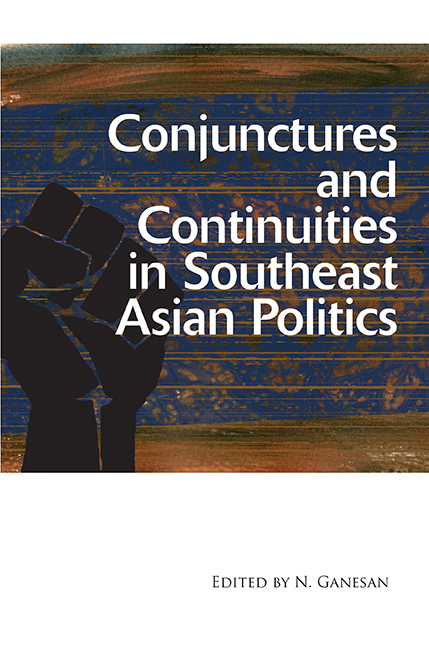Book contents
- Frontmatter
- Contents
- Acknowledgements
- List of Abbreviations
- Contributors
- 1 Conjunctures and Continuities in Southeast Asian Politics
- 2 (Re)Assessing the EDSA “People Power” (1986) as a Critical Conjuncture
- 3 The Road to Doi Moi in 1986: Domestic Dimensions
- 4 The 1988 Uprising in Myanmar: Historical Conjuncture or Praetorian Redux?
- 5 Cambodia's Historical Conjunctures and their Significance
- 6 Changing the Rules: Historical Conjuncture and Transition in Indonesia
- 7 The Resistible Rise of Thaksin Shinawatra: Crisis, Change and the Collapse of Thailand's Democracy
- 8 The March 2008 General Election in Malaysia as a Historical Conjuncture
- 9 Conclusion: Conjunctures and Continuities in Southeast Asia
- Index
9 - Conclusion: Conjunctures and Continuities in Southeast Asia
Published online by Cambridge University Press: 21 October 2015
- Frontmatter
- Contents
- Acknowledgements
- List of Abbreviations
- Contributors
- 1 Conjunctures and Continuities in Southeast Asian Politics
- 2 (Re)Assessing the EDSA “People Power” (1986) as a Critical Conjuncture
- 3 The Road to Doi Moi in 1986: Domestic Dimensions
- 4 The 1988 Uprising in Myanmar: Historical Conjuncture or Praetorian Redux?
- 5 Cambodia's Historical Conjunctures and their Significance
- 6 Changing the Rules: Historical Conjuncture and Transition in Indonesia
- 7 The Resistible Rise of Thaksin Shinawatra: Crisis, Change and the Collapse of Thailand's Democracy
- 8 The March 2008 General Election in Malaysia as a Historical Conjuncture
- 9 Conclusion: Conjunctures and Continuities in Southeast Asia
- Index
Summary
The case studies from Southeast Asia examined in this book appear to indicate that there have been a large number of developments that can be considered critical conjunctures in the last two decades or so. The country experts that were selected for this project obviously appear to think so and go on to offer compelling reasons on why particular events constitute the equivalent of conjunctures. In line with the requirements of the project, authors were tasked to trace antecedent conditions prior to the occurrence of a conjuncture. Similarly, they were then required to describe the changes that had been brought about by the said conjuncture. Particularly important in this regard is the appearance of contingent conditions that allow for the unfolding of various possibilities. Similarly, authors were also tasked to identify how a chosen course of action resulted in path-dependent outcomes that were subsequently replicated and acquired a certain trajectory that then became embedded over time. Other important questions pertain to the types of triggers for the conjuncture and the importance of structural and agency reasons for the path-dependent consequences. This concluding chapter ends the book with a discussion of broader theoretical concerns and trends that the book has highlighted.
BROADER TRENDS AND OBSERVATIONS
There are a number of important theoretical considerations that arise from these case studies. One of the major ones would be whether a conjuncture was made possible by external developments and if so whether the nature of such a development was broad-based or not. The preliminary evidence suggests that the Asian financial crisis served just such a function and was responsible for the downfall of the Soeharto regime in Indonesia and the meteoric rise of Thaksin Shinawatra in Thailand. Both countries were severely affected by the crisis and the Indonesian and Thai case studies indicate how post-crisis developments eventually led to the unfolding of a conjuncture.
- Type
- Chapter
- Information
- Conjunctures and Continuities in Southeast Asian Politics , pp. 217 - 224Publisher: ISEAS–Yusof Ishak InstitutePrint publication year: 2013



